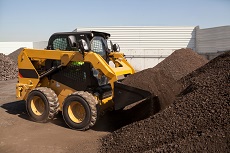
A skid steer loader is a handy piece of equipment that can be used for various tasks: snow removal, earthmoving, landscaping, roadwork, and carrying materials. Manufacturers offer these loaders in various sizes and many options in hydraulic capacity and engine horsepower. If you want to use one at your job site, you need to choose the right size for the job.
A small skid steer loader is ideal for jobs in tight spaces, like landscaping, interior demolition, and underground construction. The more petite frame makes its transportation to the job site easier.
Here are some things you need to consider while buying a skid steer loader.
- What Kind of Rated Operating Capacity Do You Need?
Every skid steer has a specific rated operating capacity which is mentioned in the specifications. The ROC refers to the weight the loader arms can handle while lifting. If the skid steer loader can lift material off the ground but cannot lift more than a foot or two, the load exceeds the rated operating capacity.
According to the experts, a small skid steer can safely lift 1550 pounds while its larger counterparts can lift 3700 pounds.
When shopping for a skid steer, make sure the rated operating capacity is equal to or more than the weight of the items you plan to lift at the job site.
- What Kind of Lift Arrangement Do You Need?
The skid steer loader has two types of lift arrangements – vertical lift and radial lift arrangement. Operators that do more grading and dirt work prefer a radial lift arrangement as it allows the equipment to have a larger size bucket attachment.
The radial-lift arrangement also offers excellent mid-height reach. If the operator does more truck loading, then a vertical lift arrangement is ideal for the job. The vertical lift loader has a higher rated operating capacity, which can reach full dump height.
- What Types of Attachments Do You Plan to Use with the Skid Steer Loader?
Before you decide on any model, determine the attachments you plan to use with the equipment. Not all attachments will fit on a small steer loader. You need to look at the attachment requirements that will determine the size of the steer loader, rated operating capacity, engine horsepower, and hydraulic flow.
- Which Cab Features Do You Need?
Cab comfort is an essential consideration while choosing any size skid steer loader. Do you need a closed cab with air and heat due to working conditions on the job site? Can you have an open cab? To ensure the operator’s safety and comfort, you need to find the best cab layout for the skid steer loader.
- Does the Skid Steer Loader Offer Good Sightlines?
Visibility is a crucial factor in performing any job safely with the skid steer loader. The equipment should offer good sightlines to all areas around the equipment for safe operation and maximum efficiency. You need to look for additional features like backup cameras and sensors to detect objects and workers in blind spots.
- What Features the Skid Steer Loader Has to Increase Efficiency?
You need to look for features that are related to everyday tasks done with the small skid steer. Features like creep speed control for a high-quality finish, return-to-dig for truck loader cycles, and dual-direction self-leveling for material handling/loading reduce operator’s stress.
- What Are the Transportation Requirements?
Transporting a small size loader is not a problem. To be on the safer side, you have to understand the transportation requirements of the skid steer loader. Make sure the towing vehicles and vehicles match the load and size requirements of the equipment. Besides the size and weight of the machine, you need to also consider the size and load of the attachments that need to be transported to the job site.
It would help if you used metal ramps to load the machine on the trailer as wooden ramps might not support the weight of the skid steer loader and break, leading to injuries.
- What Are the Controls Offered?
Skid steer loader models come with a variety of controls like lever and pedal controls. However, many new models have joystick controls that can be operated with less force.
While the joystick offers more precise control over the machine, some operators might not be comfortable with it and prefer pedals or levers. It will help if you look for a skid steer loader that offers joystick controls with optional pedals and lever controls to guarantee operational flexibility.
To sum up, these are the vital factors you need to focus on while buying a compact skid steer loader.






